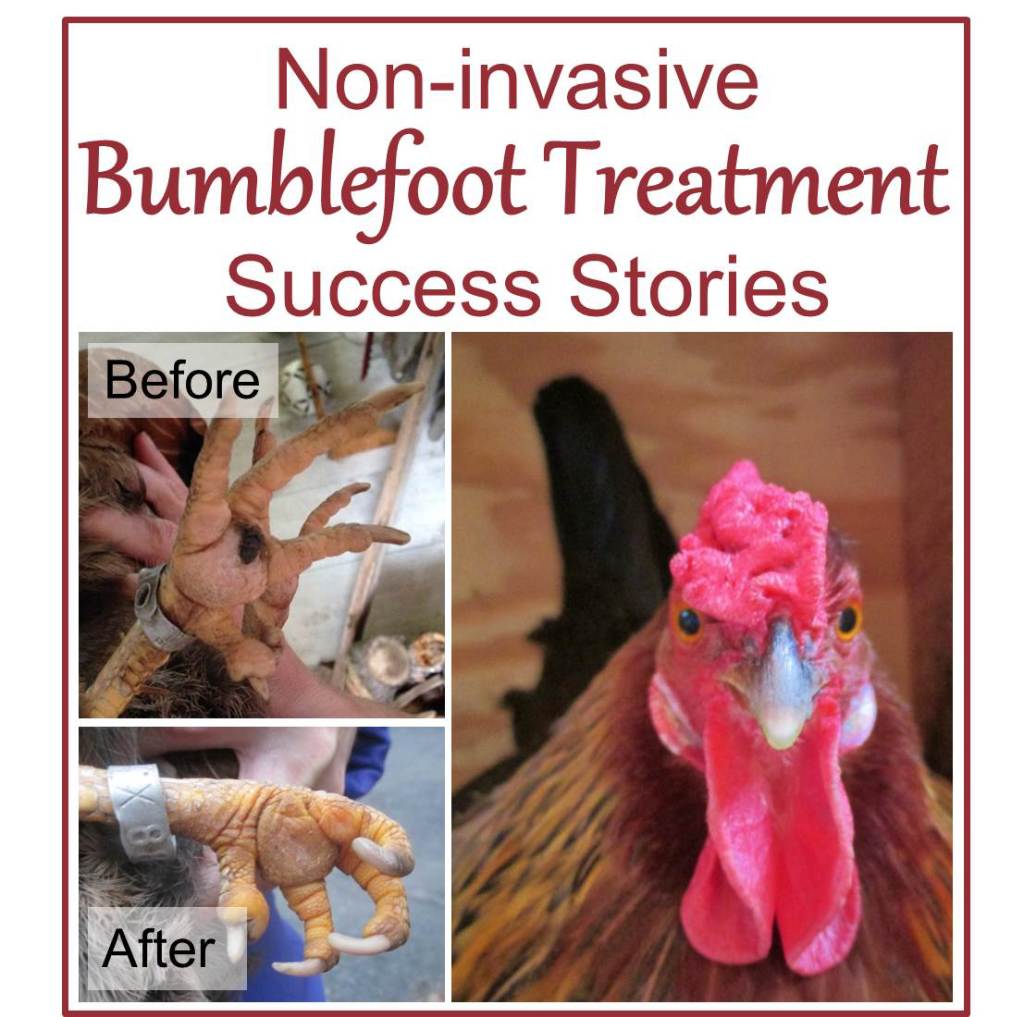
This is a follow-up to my first post on bumblefoot treatment with TricideNeo. Success stories with before and after photos are presented here.
It has been a year since I first wrote about bumblefoot treatment with TricideNeo, and since then, I’ve accumulated some success stories for which I have “before” and “after” photos. To my knowledge, there are no other online before and after photos of this treatment, so I thought I’d share these 4 cases here. One case is mine, and the other 3 come from readers. The importance of this approach is that it’s painless for the chicken and easy for the owner.
Non-invasive bumblefoot treatment: Success stories
The details of obtaining, using, and disposing of TricideNeo are covered in detail here. In brief, daily soaks of 5-10 minutes until complete healing have been recommended, based on experience with this medication in the treatment of skin ulcers on koi fish. However, the use of this medication for bumblefoot has not been systematically studied, so nobody really knows how often and for how long it should be used. Daily soaking is cumbersome for many people, and in all of the following 4 cases, soaks were done less frequently. Click here to learn more about what TricideNeo actually is.
This post contains links to online shopping, which is a way for you to support One Acre Farm at no additional cost to you. Click here for my full affiliate disclosure. Thanks for your support!
Case 1
This is one of my hens. I first noticed her limping in early August, 2014, and began daily, 5-10 minute TricideNeo soaks in mid-August. The “before” photo in this case is actually after a 1-2 weeks of soaks, by which time the swelling had diminished and the limping was less pronounced. The appearance of the black scab, however, was unchanged. I needed an assistant to photograph the bottom of the foot, and did not have one until late August.
On average, I gave her 5-10 minute soaks about 4 days per week, through late October. By then, the black scab was beginning to shrink, and she was not limping at all, so I reduced soaking to 1 day per week. By late November, the scab was gone and the foot looked totally normal. The “after” photo was taken on November 24, 2014.
Case 2
This hen belonged to a reader who reported persistent bumblefoot despite “many months of numerous surgeries and squeezing”. He gave up on surgery and began daily soaks with TricideNeo on August 29, 2014. The “before” photo of this hen’s foot is before the TricideNeo soaks, but after numerous surgeries. After about 4 weeks of daily soaks and minimal improvement, the owner left for a 1 week long business trip, during which time the hen received no treatment. Upon his return on September 30, the lesion was completely healed.
Case 3
This hen belongs to another reader. The owner never attempted surgery, but began TricideNeo soaks in November of 2013. Between then and late January of 2014, she gave the bird “3 rounds of soaks”, two 1-week periods, and another 3-4 day period. Swelling and redness were gone after the first 1-week stretch of soaking. The scabs gradually shrank and faded, and were substantially improved by late January. I do not know exactly when the scabs completely disappeared, but the owner provided “after” photos on July 9, 2014, to show that there had been no relapse or recurrence.
A confounding issue is that she also gave beta carotene orally (I’m not sure how often) and once applied Vetericyn VF gel spray. But since there is no consistent evidence of either beta carotene or Vetericyn curing bumblefoot, it’s not likely that they were important factors.
Case 4
This rooster belongs to the same person as the hen in Case 3, and received exactly the same treatment during the same time period. See “before” and “after” photos below.
Final comments on bumblefoot treatment with TricideNeo
-
These cases do not prove that TricideNeo is effective against bumblefoot, because they are merely anecdotal reports. They are suggestive, but they are not proof.
- At this point in time, there are no published placebo-controlled studies of the effectiveness of TricideNeo on bumblefoot (to my knowledge). Anecdotes are all we have.
- Anecdotal evidence suggests that daily soaking is unnecessary. And, if future controlled studies show that TricideNeo is an effective treatment for bumblefoot, additional studies to determine the optimal length and frequency of soaks should be done.
- None of these 4 cases were severe (extremely large). Whether this medication would work for severe bumblefoot remains to be seen.
What has been your experience with TricideNeo for bumblefoot? If you try it in the future, please take photos of the foot before and after treatment. Email them to janet (at) OurOneAcreFarm (d0t) com, along with a summary of the treatment, and I may add them to this post. I would also like to hear about failures with this treatment!
Shared on: Tuesdays with a Twist, Homestead Blog Hop











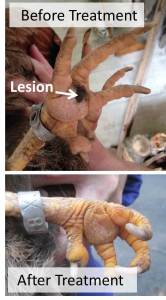
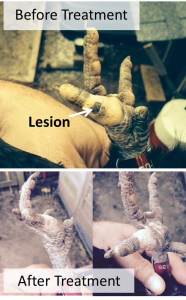
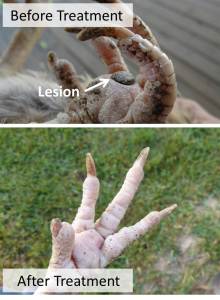
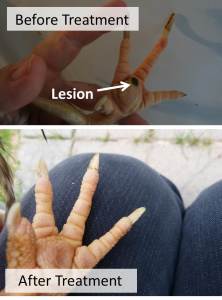
Hi Janet!
Thank you for the report on the cases of bumblefoot, I am also delighted to know that your hen got cured. After looking at the pics I realize that my hen has a very mild case, her scab is small and light in color and the swelling is minimal. I have been treating her daily for 13 weeks (missing one day every now and then), the scab is still there (no changes) but I am afraid to stop the treatment because I don’t want it to get larger. At this point I do not know what to do, I believe 13 weeks of soaking should have made the “trick” but apparently it has not, however it may have kept the infection at bay. I wonder if the small scab is going to be there all the time and if I should start spacing the soaks like you did with your hen and just do it once a week.
I am so very aware that all this is trial and error and what works for one will not work for another. I really wish we could count with some scientific studies that would give us the correct answers.
Hi Aldara, could you send me a photo of scab? Also, are you doing anything else other than TricideNeo soaks? Are you wrapping it? Administering any other type of medication, herbal treatment, etc.?
Pingback: Bumblefoot treatment with TricideNeo - One Acre Farm
Pingback: Non Invasive Bumblefoot Treatment And Success Stories | Homestead & Survival
can this treatment be used on Pekin Ducks as well?
Lori, it is approved only for use on skin ulcers in fish, so no one knows if it’s really effective even on chickens, but anecdotal evidence suggests that it is in mild and maybe moderate cases. I don’t know of anyone who has tried in on a Pekin duck, so you will have to decide whether to give it a go. If you do, I would love to know how it works out.
I live in England. Just managed to get hold of some tricideneo, could I soak a wad of lint and bandage it to the bumble foot and leave it on god a day?
I would not do that, Sue. Prolonged exposure causes skin breakdown in fish, for which TricideNeo was developed and tested. Chicken feet may be tougher, but I would not leave it on all day, as it might well cause the skin of the foot to breakdown.
Hi Sue
I also live in Uk (Wales) and am desperately searching for Tricide Neo
Please could you tell me where you obtained the product?
Many thanks
Eve
I am in uk where did you buy TN
Pingback: Chickenpalooza! Homestead Chicken Resources
Hello there…stumbled across this…pun intended…but I would like to add my two cents worth. I only have experienced bumble foot on my meat chickens…when I had Cornish X’s. They were pastured and moved daily. Only five or ten out of fifty. Since I use the feet for making stock, I don’t think I would use any feet that had been treated with Tricide Neo. Just like Cut-N-Heal or Vetricyn, it is not supposed to used on livestock meant for human consumption. That being said, I had several meat chickens attacked by….a predator that ripped the fragile skin under the wings. I used Cut-N-Heal one time and when we butchered them about 3 weeks later, we found no scar tissue or any evidence of injury. Pretty awesome stuff. Sill, no studies have been done on the effects on humans.
Now Cut-N-Heal is made with balsam of fir, linseed oil,fish oil and tea tree oil. But the label clearly states, “Not for food producing animals or cats. Not for human use.” On the other hand, Vetrycin is made with, among other things, hypochlorous acid, sodium hypochlorite, Lithium magnesium sodium silicate, and phosphates. The MSDS sheets states if ingestion occurs, “This product may be harmful if ingested. Depending on the amount swallowed, ingestion may cause mild irritation to mouth, throat, stomach and gastrointestinal tract.”
So, considering the ingredients, I’d go with Cut-N-Heal on livestock intended for food.
I could find no MSDS sheets for Tricide Neo and thus the point of my comment is that I would not use it for livestock intended for food.
Just my two cents worth.
Pam
Thanks for your input, Pam. I wouldn’t use TricideNeo if I were going to use the foot for food, either, but I’d probably choose to treat with TN and then not eat that bird’s feet.
Cut-n-heal is just to protect minor cuts from infection. It doesn’t treat existing infection. Bumblefoot is a serious infection, and the infecting organism is often Staph. aureus, difficult to treat bacteria. I’d be surprised if cut-n-heal treated bumblefoot successfully. TricideNeo contains an antibiotic that kills Staph. aureus.
I just purchased TricideNeo and it came in the mail yesterday so tonight I am going to soak my hens foot. She has a bad case I believe it’s not swollen up thru the toes but it’s swollen. I did try surgery but it wasn’t successful. So I am trying this. I will send pictures of before and after. And let you know how exactly it went. My question is can you tell me exactly how much TricideNeo to put in a quart of water?
Thank You,
Lacy
Hi Lacy, I don’t remember off hand, so you will have to calculate it out. It says on the packet how much to put in 1 gallon, so you will have to divide that by 4 to get the quantity needed for 1 quart. You will need to use a scale that can measure small quantities, or you can estimate it visually. For example, if you bought enough for 1 gallon of water, divide powder into 4 equal piles and put 1 of them into 1 quart of distilled water.
Pingback: Homestead Chicken Resources - Everything for Your Backyard Flock
My cockerel has developed Bumble foot and I should like to try the Tricide Neo on him.
Please can you tell me how to get hold of it?
Thanks
Eve
I got some of this in the mail today. The directions say to isolate the fish. Do you also have to isolate the chicken? Also, do you rinse the feet after?
Hi There – Thank you for the great information. I have a little guinea pig who had a scab that fell off while doing an epsom salt soak. Do you think this product would work for a guinea pig? Any help you could give us would be greatly appreciated. Also, is it good when the scab comes off? (It seems I’ve heard of surgical removal of them so hoping that it falling off on its own is a good thing.) Thanks again! Julie
Hello Ms. Janet,
I was wondering if you personally eat the eggs of a chicken treated with the feet soaked in Tricide Neo?
I’ve been soaking my hens (bumble foot infected) feet with hot Epsom Salt solution daily for 12 minutes each soaking session. After soaking I apply Silver Sulfadiazine cream and bandage up the foot with vet wrap. It’s been approximately two months since beginning this treatment and while there’s been some improvement the bumble foot is still there. I’m going to try the Tricide Neo soak and was wondering if I should continue the Epsom Salt soak prior to the Tricide Neo soak? Please advise.
I have a rooster with SEVERE SEVERE bumblefoot! I thought it was mites at first and treated as such, then some tragedy happened in our lives, and unfortunately his treatment had to go on the back burner. Now it is out of control! He’s been on antibiotics now for almost two weeks and I can tell he feels much better. He wants around on these huge feet like its nothing, and now after antibiotics he’s even running again. His comb color is GREAT and he crows often. Just these feet!!!!!! I would love to send you photos and get your advice on whether I should attempt surgery or just do the oral antibiotics and the neo soaks. I haven’t purchased any yet but plan on it based on your opinion. I mean at this point it couldn’t hurt and I’m willing to try anything because, well, I’ve basically got nothing to lose for him. He can’t be completely comfortable though you’d never know he wasn’t. Let me know if you’d be willing to look at some photos. Thank you so much.